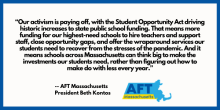A new state budget has taken effect, and for the third year in a row, it includes an enormous increase in state funding for public schools thanks to the landmark Student Opportunity Act, which became law in 2019 after years of advocacy by AFT Massachusetts and our allies.

“Our activism is paying off, with the Student Opportunity Act driving historic increases to state public school funding,” said AFT Massachusetts President Beth Kontos. “That means more funding for our highest-need schools to hire teachers and support staff, close opportunity gaps, and offer the wraparound services our students need to recover from the stresses of the pandemic. And it means schools across Massachusetts can think big to make the investments our students need, rather than figuring out how to make do with less every year.”
The new FY24 state budget signed by Governor Healey on Wednesday represents the third of six years of implementation of the landmark Student Opportunity Act, which lays out a series of increases to state education funding through the 2026-2027 school year.
This year, the state budget includes:
- $6.59 billion in Chapter 70 school aid, a $604 million (~10%) increase over FY23.
- A doubling of the minimum Chapter 70 aid level from $30 to $60 per pupil.
- $505 million for the Special Education Circuit Breaker, a $65 million (~14%) increase over FY23, which reflects a full phase-in of the out-of-district transportation cost reimbursement provided for in the SOA.
- $233 million to fund the charter school reimbursement line item.
In order to get the Student Opportunity Act passed, public school advocates across the state, including AFT Massachusetts, joined together in the Fund Our Future campaign. Tens of thousands of AFT Massachusetts members and other advocates made phone calls, sent e-mails and letters, attended rallies and forums around the state, and demanded transformative investments in Massachusetts public schools.
Due to the campaign’s aggressive campaigning and deep commitment to education justice and equity, the Student Opportunity Act directs the lion’s share of new resources to communities with the highest concentrations of low-income students.
Among AFTMA locals, this year’s budget will include:
- $477,737,768 in Chapter 70 aid for Springfield, a 26.7% increase from $377,169,775 in FY21 (before SOA implementation began)
- $269,092,167 for Lynn, a 35.1% increase from $199,154,994 in FY21
- $266,144,831 for Lawrence, a 28.4% increase from $207,256,303 in FY21
- $14,141,800 for Chelmsford, a 26.3% increase from $11,199,428 in FY21
- $22,134,306 for Southeastern Regional Voc-Tech, a 31.2% increase from $16,871,155 in FY21
To find the total for your district or school, view the state’s estimates for municipalities and regional school districts.
While it makes historic investments in our students, this budget still represents only the third of six years of major increases to K-12 education spending that are required under the Student Opportunity Act. Additional increases will be required in the next three state budgets to ensure that the state of Massachusetts is providing adequate resources to our local schools.
“This budget shows what Massachusetts can do when we focus on investing in our students and their families, and it provides a model that must be built on in upcoming annual budgets,” Kontos said. “Amid the strain of inflation on school budgets and the growing academic and social-emotional needs of students, the state must ensure that this promise of opportunity for all is fulfilled over the next three years. If we want Massachusetts to be a place where every student is given the tools to succeed and thrive, we need to continue making new investments like this every year.”
